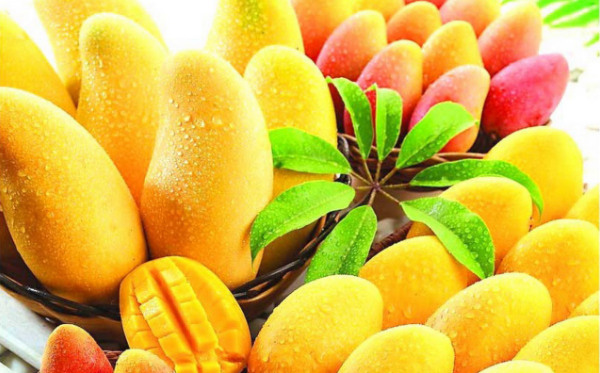The fruits of mango include the fleshy (drupa) fruits, of varying size and shape depending on the variety, ranging from round (eg gedong mango), round egg (gadung, indramayu, arumanis) to long tapering (mango golek) . The fruit length is approximately 2.5-30 cm. At the end of the fruit, there is a pointed part called the beak. Above the beak there is a bending section called sinus, which continues to the abdomen.
The skin of the fruit is rather thick speckled glands; green, yellowish or reddish when ripe. Flesh if ripe red orange, yellow or creamy, stringy or not, sweet to sour with lots of water and smell strong until weak. Seeds are white, sprawled elongated endocarp thick, woody and fibrous. This seed consists of two pieces; some are monoembrional and some are polyembrional.
The following is the nutritional value present in mango
Nutritional Value of Mango per 100 g (3.5 oz, Energy 272 kJ (65 kcal), Carbohydrate 17.00 g, Sugar 14.8 g, Dietary fiber 1.8 g, Fat 0.27 g, Protein 0.51 g, Vitamin A equiv. 38 mg (4%), Beta-carotene 445 mg (4%), Thiamine (Vit B1) 0.058 mg (4%), Riboflavin (Vit B2) 0.057 mg (4%), Niacin (Vit (B5) 0.160 mg (3%), Vitamin B6 0.134 mg (10%), Folate (Vit B9) 14 mg (4%), Vitamin C 27.7 mg (46%), Calcium 10 mg (1%), Iron 0.13 mg (1%), Magnesium 9 mg (2%), Phosphorus 11 mg (2%), Potassium 156 mg (3%), Zinc 0, 04 mg (0%).
Results and usability
Mango is mainly grown for the fruit. Mature fruits are commonly eaten fresh, as a fruit table or a mixture of ice, in the form of slices or blenders. The young fruit is often dirujak, or peddled on the edge of the road after peeled, split and equipped with salt spice with chili. Mango fruit is also processed as sweets, dried fruit slices, canned and others. In many parts of Indonesia, mango (old or young) sour is often used as a mixture of sambal or fish and meat dishes.
Mango seeds can be used as animal feed or poultry; in India even used as food in times of famine. The young leaves are engulfed or made into vegetables. Mango wood is strong enough, hard and easy to work; but less durable for outside use. This wood can also be a good charcoal.
Mango leaves contain tarakserol-3beta organic compounds and ethyl acetate extracts that synergize with insulin activate GLUT4, and stimulate glycogen synthesis, thereby reducing symptoms of hyperglycemia. [2]
Mango is mainly produced by the countries of India, China, Mexico, Thailand, Pakistan, Indonesia, Brazil, Philippines, and Bangladesh. Total world production in the '80s was about 15 million tons, but only about 90,000 tons (1985) were traded on a global level. That is, most of the mango is consumed locally.
Meanwhile the main market of mango is Southeast Asia, Europe, USA and Japan. Singapore, Hong Kong and Japan are the largest importers in Asia
